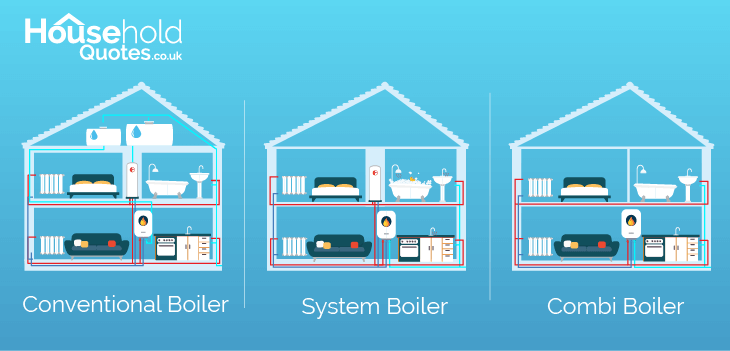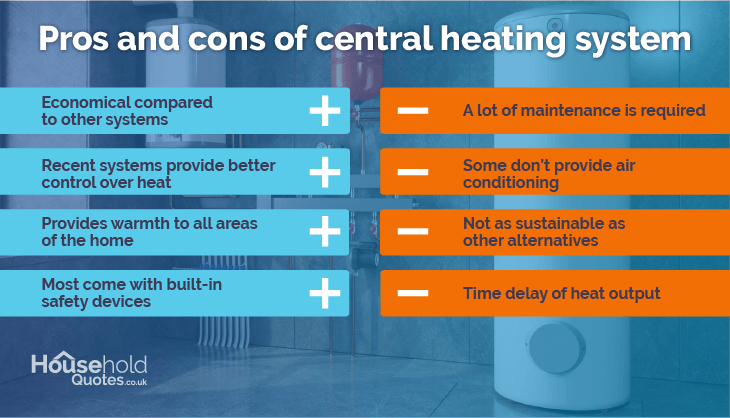
Get up to 3 quotes by filling in only 1 quick form

Compare quotes and find yourself the best deal

Increase the value of your home by installing a new boiler
- Householdquotes.co.uk
- Central Heating Installation Costs
Central Heating Installation Costs in the UK: 2024 Guide


Have you recently purchased a home with an outdated electric storage heating setup, and are thinking of converting the central heating system to gas central heating? Or maybe you’re renovating an older home, and want to replace the central heating system with a completely new boiler, pipework, radiators, and heating controls. On average, central heating installation can cost anywhere from £2,000 to £5,000 but there are many variables to consider.
Knowing what the best gas boilers are for you and your property can be hard with different styles, energy efficiencies, and outputs to consider. You also may want to factor in what’s in style, what suits your property, and your needs. Let’s examine the cost of new central heating systems in the UK and go over some cost factors.
In this article, we will cover:
- How much a central heating system costs
- What affects the cost of central heating
- What’s involved in installing a central heating system
- How to find and hire a heating engineer
If you’re considering changing your heating system or getting a replacement boiler but aren’t sure where to begin, keep reading to find out the most cost-effective way of introducing a new central heating system into your home.
However, if you’ve already made up your mind about getting a new heating system, there’s one thing you’ll need above all: an installer you can trust. Usually, finding professionals whom you can rely on can take days of painstaking research and price comparisons. However, we can simplify the process so you can sit back and relax.
Our handy service can help you obtain up to 3 free, non-binding boiler quotes from trusted installers in your area. All you need to do is fill out a 30-second form and you can view prices from multiple sources and compare them to see what suits your needs best. Click the button below to get started.
- Quotes from local installers
- Payment by finance available
- Save up to £975
It only takes 30 seconds

- How much does a central heating system cost?
- What affects the cost of central heating in 2024?
- How can I save money on a new central heating system in the UK?
- What’s Involved in Installing a central heating system?
- Is central heating the best choice for my home?
- How do I find and hire a heating engineer?
- Ensuring the professional is the right fit
- Final checklist
- Frequently Asked Questions
How much does a central heating system cost?
The cost of installing central heating in a home typically ranges from £2,000 to £5,000 depending on the type of system installed, its size, and the requirements of the home. The average cost of installing central heating systems can be around £3,500 to £4,000. As with all the prices listed in this guide, it’s good to keep in mind that prices in London and the South East of England will be a little higher than average.
Below is a table outlining some estimated costs based on the size of the property, number of radiators and boiler size. The best boiler for a 3 bed house (the most common home in the UK) should be about 18kW to 34kW.
| House Size | Number of Radiators | Boiler Size | Time Required | Estimated Total Cost |
|---|---|---|---|---|
| Bungalow | 5 to 6 | 24kw | 1 to 2 days | £2,000 to £2,600 |
| Terraced House | 6 to 9 | 28kw | 2 to 3 days | £3,500 to £4,000 |
| Semi-detached House | 10 to 12 | 33kw | 3 to 4 days | £4,000 to £4,500 |
| Detached House | 12 to 15 | 33kw | 5 to 7 days | £4,500 to £5,000 |
These costs are estimates. Get a local installer QUOTE now!
Installing central heating in a bungalow with five to six radiators and a 24kW boiler is estimated to cost £2,000 to £2,600.
Installing central heating in a terraced house with six to nine radiators and a 28kW boiler is estimated to cost between £3,500 to £4,000.
Installing central heating in a semi-detached house with 10 to 12 radiators and a 33kW boiler is estimated to cost between £4,000 to £4,500, while a detached house with 12 to 15 radiators and a 33kW boiler is estimated to cost between £4,500 to £5,000.
What affects the cost of central heating in 2024?
If you’re trying to upgrade your home’s heating on a tight budget, there are some things to watch out for that can drive your costs up.
While there are some factors you can’t change – such as the number of storeys in your home, or the number of bedrooms – there are ways to make sure the project price stays manageable even while working on a large property.
Here are some of the main factors any new central heating system cost calculation should include:
The size of your home
Going hand-in-hand with the radiators you choose, the number of rooms in your property will be a direct hit on your budget. The more rooms you have, the more radiators you need, meaning more products and longer installation periods for your contractors. Central heating installation cost for a 3 bedroom house can range from £3,000 to £4,000, while a house with 4 bedrooms can cost £3,500 to £4,500.
If you have large rooms, you might need more than one radiator to sufficiently heat it up. Your contractors will be able to calculate the heat output required for each room in British Thermal Units (BTUs).
Your choice of boiler

Single-handedly raising or lowering your renovation costs is the boiler itself. Whether or not you choose a combi boiler vs system boiler, LPG boiler or biomass boiler will impact your costs, as well as the output of heat in your home. When comparing electric boiler vs gas boiler running costs, electric can be more expensive.
However, gas boiler running costs can fluctuate based on gas prices and may not be available for new homes soon (if a gas boiler ban goes through as intended). So, are gas boilers being phased out? Potentially, yes. That’s why parts may become less accessible in the future as everyone moves towards electricity.
Aside from fuel type, the boiler type also matters. In most cases, a like-for-like boiler replacement is the most cost effective option. The only time you cannot do this is during a back boiler replacement, since these outdated boiler are not available anymore.
Let’s go through the choices:
Combi boilers
Traditionally more popular than conventional boilers, combi boilers work by heating water from the mains supply instead of waiting on a hot water tank. This gives immediate hot water on demand, which is where the combi boiler gets its allure from with homeowners.
Additionally, combi boilers are ideal for smaller homes as they do not require any additional storage tank or cylinder. Everything needed to heat your home is within the boiler itself. If your home is smaller and up to two bathrooms, then a small combi boiler might be of interest to you.
Learn more about combi boiler flow rate in our guide.
Including the cost of moving any existing pipework and completing a mechanical flush before installation, combi boilers can set you back by around £2,000 to £3,000.
Changing to a combi boiler from a system or conventional boiler could cost you even more since this type of swap will involve removing external units, such as the hot water cylinder and/or cold water tank, and adjusting the surrounding pipework.
If you wish to learn more, check out our comprehensive guide on combi boiler costs. We also have detailed guides to the best combi boilers and oil-fired combi boilers too!
Conventional or regular boilers
For a standard boiler installation, you can expect to pay between £2,600 to £4,300. This will be dependent on the output of the boiler, as well as the size of the team working on installing it, together with regional factors that can raise or lower your costs based on your location.
For more information, check out our guide to conventional boiler costs to learn about purchase prices and installation costs.
System boilers
System boilers are most suited to large properties with two or more bathrooms. They require a lot of room to be housed along with ample space to accommodate a hot water tank or cylinder. This makes them a popular choice for larger homes with more extensive water needs.
Costing anywhere between £1,300 to £4,300 depending on the output you choose, system boilers give instant access to hot water and can be used in conjunction with solar panels if desired.
Our guide to system boiler costs covers everything you need to know, including how much they cost, what affects the cost of fitting a system boiler, how to save money, and much more.
Liquid petroleum gas (LPG) boilers
Another boiler option comes in the form of the LPG boiler. These are commonly seen in properties off the national grid, without a mains source of gas to connect to.
LPG is a fossil fuel, and as such, releases carbon dioxide and other harmful gases, despite it being billed as a ‘cleaner’ fuel than other fossil fuel options. The cost of fitting will be between £1,600 to £2,000, and you’ll need a tank fitted to store your gas which can cost upwards of £1,500.
If you’re considering one for your home, our in-depth guide on LPG boiler costs explains everything that you need to know. Similarly, another off-the-gas-grid option is to get a new oil boiler replacement.
Biomass boilers
By far the most expensive option is the biomass boiler, tipping the scales at £10,000 to £14,000 for fitting in a four-bedroom detached home, for example.
Something to consider is the Boiler Upgrade Scheme (BUS) which potentially offers you a grant of £5,000 off the cost of supply and installation. Between 2022 and 2025, there is £450 million worth of funding available as part of this scheme.
The scheme also grants £7,500 off the costs of the costs of a new heat pump. Check out our page about heat pumps vs gas boilers to learn more about this renewable heating system and its benefits compared to traditional boilers.
Adding to the neutralities, the use of a biomass boiler itself is carbon-neutral, as the burning of biomass fuel emits the same amount of carbon dioxide absorbed by the fuel while it is growing. To make the process truly carbon neutral, you should make sure how your wood is being sourced. If trees are not being regrown at a fast enough rate, your processes may not be eco-friendly.
To learn more about these unique boilers—including how much biomass fuel costs—please visit our complete guide to biomass boiler costs and specifications.
Regardless of what type of boiler you choose, you will need an installer you can trust to get the job done. Ordinarily, this can take days of laborious research and price comparisons but we can simplify the process for you. Our handy service can put you in contact with up to 3 thoroughly vetted installers from our network and all you have to do is fill out a 30-second form.
Let us do the heavy lifting so you can make the most of your precious spare time. Click the button below to obtain multiple free, non-binding quotes from trusted installers near you:
- Quotes from local installers
- Payment by finance available
- Save up to £975
It only takes 30 seconds

How many radiators you need
Aside from the boiler you choose, the number of radiators you need will impact your new central heating system cost.
The more ornate the style, the higher the price, with some models coming in anywhere between £150 and £1,000, whereas standard central heating radiators range from £20 to £120 depending on their heat output.
To be cost-savvy, you can look to get hold of your chosen type of radiator while they’re on offer, ahead of when your work is scheduled to start. This way, you still get the look you want but for much less than the RRP (recommended retail price).
If you’re curious to learn more, check out our guide to radiator costs.
Ease of installation
Something to consider is whether or not you’ll be on the property while the new heating system is being installed. If you’re able to, going to stay somewhere else for a little while can help expedite the process for the contractors as they’ll have fewer barriers while working.
Similarly, if you can move furniture or appliances out of the way before the contractors arrive this will help to streamline their process and keep them focused on the job at hand, instead of being an ad-hoc removals company, too.
Whether you choose traditional or wireless controls

Having intelligent controls installed as part of your central heating overhaul is vital to getting the most out of your system. Nowadays, you can even use your phone to control your thermostat and adjust the temperature of your home.
Installing thermostats in each room is the best way to achieve the ideal temperature in each space and maximise energy efficiency. When used in conjunction with TRVs (Thermostatic Radiator Valves), individual thermostats can save you money whilst keeping you comfortable.
A heating engineer will supply and install new wireless room thermostats for between £100 and £200 per room. You may be able to negotiate lower labour costs if you decide to install more than one thermostat. Installing thermostats takes around two hours per room.
Once complete, you should experience noticeable heat differences, as well as better environmental control.
The size and scope of your project
The time involved and the price will differ greatly on the size of your property, the number of radiators you want fitting and whether or not your home is a single or multi-storey residence.
To ensure your new central heating installation is as energy efficient as possible, the hot water cylinder will be insulated and fitted with a thermostat, and your contractor will install all radiators with thermostatic radiator valves (TRVs) so that your radiators will work autonomously to keep your home at your desired temperature.
To illustrate these costs, here’s a sample costing strategy for installation for a four-bed, two-storey home:
- New boiler including supply and labour: £2,000 to £10,000
- Nine radiators including supply and labour: £1,000 to £1,500
- Water tank supply and install: £150 to £200
- Miscellaneous extras parts and labour: £100 to £300
- Pipework supply and installation: £800 to £1,000
Whereas, the amount of work will be different for a smaller home. The gas central heating cost for a 2-bedroom home are as follows:
- Gas boiler supply and installation – £4,500 to £6,000
- Radiators parts and labour – £150 to £800
- Pipework supply and installation – £200 to £300
- Extra parts and labour – £100 to £200
This job will take about three days, but again, the exact cost will depend on the boiler you choose and your location. For such a small building, a combination boiler should be enough to provide adequate heat and hot water to the property, whereas larger properties might want to look at alternatives to heat the bigger space.
How can I save money on a new central heating system in the UK?
Comparing quotes is a great way to potentially reduce the cost of your central heating project. However, you still need to be sure the quotes are from installers that you can trust. While this can take days of research and price comparisons, services like ours can help reduce the labour on your end.
All we need is some basic information which you can fill out in 30 seconds and we can provide you with up to 3 free, non-binding quotes from thoroughly vetted installers.
Click the button below to get started:
- Quotes from local installers
- Payment by finance available
- Save up to £975
It only takes 30 seconds

Installing a new central heating system can be expensive, which is off-putting for many homeowners. But there are ways of being cost-savvy to bring prices down, all while helping to reduce your energy bills once a new, efficient boiler is installed.
If you’re planning your boiler replacement and want to renovate your radiators at the same time, checking to see if any local stores are having sales or reductions can help to bring your project fees down. The cost to replace a central heating system is significantly lower when going from gas to electricity than vice versa.
By stockpiling items in advance, you reduce the risk of having to spend a premium on items unexpectedly when the work starts and you realise you’re one radiator short. Planning in advance can take more time and effort but will pay dividends in the long run.
For qualifying homeowners and private tenants, the UK’s ‘Big Six’ energy suppliers offer free replacement boilers.
Furthermore, some homeowners and tenants can be eligible for other heat-saving schemes from the government, such as:
- Heating controls
- Loft insulation
- Solid wall insulation
- Cavity wall insulation
You can also consider zoning heating controls, which are essential for better energy efficiency, working by separating the different parts of your home into different heating zones.
For example, the system will treat each floor as a separate heating zone and will only supply heat to selected floors at certain times of the day. So, if you have children who are at university and only come home occasionally, the heating to their rooms or floor can be turned off when they are not at home, and back on when they’re back.
Zoning can help to cut energy costs considerably and is a great up-front cost to see a return on investment over time.
What’s involved in installing a central heating system?

Central heating installation is a relatively straightforward job for an expert installer. It is something that absolutely shouldn’t be tackled by a DIY enthusiast and should only be completed by a Gas Safe Registered engineer.
The only complication for fitting is how accessible your home is for laying the copper pipework for the heating system. As we’ve mentioned before, an empty house would make the installation easier and faster.
For a two-storey four-bedroom house, you can expect a team of two to take around five days to complete the installation. If, after the installation, you find your boiler leaking water, you should contact the installers at once.
Is central heating the best choice for my home?

The key advantage of central heating is how economical it is compared to other systems. It can save you money on your bills due to new advances in technology. It provides warmth to all areas of the home which is cost-efficient.
Recent systems provide better control over how the heat is dispersed which, again, is helpful for saving money. Most also come with built-in safety devices to keep your home protected – such as built-in automatic turn-off.
A disadvantage of central is a lot of maintenance is required to ensure the system runs smoothly and doesn’t break down. Central heating systems do have the potential to be less sustainable than other alternatives, which may be a concern for homeowners concerned with green energy.
How do I find and hire a heating engineer?
Finding the right heating engineer can be challenging due to all the research, vetting, and price comparisons involved. It can be a laborious task if done on your own. This is why one of the best ways to find a trustworthy installer is to use our handy service. After filling out a 30-second form you will receive up to 3 free, non-binding quotes from installers in your area.
With our help, you can easily compare multiple prices and be sure you’re receiving offers from trustworthy installers. Click the button below to tell us more about your project, and we’ll help you find someone quickly and easily:
- Quotes from local installers
- Payment by finance available
- Save up to £975
It only takes 30 seconds

When looking to hire a heating engineer for your project, you must get quotes from contractors with a checkable work history. As heating systems are complex, finding a reputable tradesperson is the first step in ensuring safety for you and your family.
If your friends, neighbours, or family have had boiler work done in their own home recently, ask them if they’d recommend their contractors. This is a great way of weeding out potential cowboy traders as your friends won’t recommend them to you if they’ve had a bad experience recently.
However, even if you are receiving a word-of-mouth recommendation, always check yourself to see if the trader is on the Gas Safe Register. This will ensure that the contractor is equipped to carry out your work safely, and without damage.
Searching online is also a great way of easily collecting quotes from the comfort of your own home with one simple search.
Ensuring the professional is the right fit
As with all home renovations, it’s best to get a written quote from your chosen contractor before agreeing to any work. While someone may say something verbally, there is no way of proving that – and if trouble arises while work is being carried out, it’s best to have something non-verbal to refer to.
If a contractor ever refuses to commit to a written quote, we’d recommend considering hiring another professional.
As we’ve mentioned before, seeking out their experience and finding out their reference history is a great way of ensuring their work is as polished as they quote it to be. Finally, your contractor should always carry their own insurance for their work, so make sure this is in place before agreeing to any project proposal.
Final checklist

Installing a new heating system in your home is a surefire way of increasing the warmth while decreasing your energy bills as you get rid of an inefficient, old boiler.
Here’s our final checklist to make sure you’ve got everything you need to take on this project with confidence:
- Weigh up the pros and cons of the different types of boilers, and settle on the one that’s right for you and your home
- Get a written quote from your contractor, and double-check they have insurance and they are on the Gas Safe Register before agreeing to any work
- Try to buy your supplies on sale to reduce costs on items such as radiators
- If possible, leave your home for the duration of their work to expedite the process and ensure a smooth working environment for your contractors
- Install digital heat controls to create a cost-effective home
Alternatively, if you want to get a general idea of the cost of a new central heating system in the UK, you’ll need to contact an installer. However, this can be a cumbersome process that could take days of researching and comparing prices. Thankfully, our handy service can streamline your search and minimise the hassle.
All you need to do is fill out a 30-second form and we can provide you with up to 3 free, non-binding quotes from thoroughly vetted professionals. Click the button below to get started.
- Quotes from local installers
- Payment by finance available
- Save up to £975
It only takes 30 seconds

Frequently Asked Questions
Yes. Initiatives like the Boiler Upgrade Scheme and the ECO+ scheme help homeowners pay for new heating systems. There are also other measures you can take to save costs of heating installations.
For a three-bed house with 9 to 10 radiators, it can cost around £3,500 – £4,000 to install a new heating system. This is only an estimate and can vary based on a number of other factors.
Central heating installation can cost from £2,000 to £5,000 depending on a number of factors.

Rawal Ahmed is a writer at Household Quotes with an interest in sustainability and a background in tech journalism and digital marketing.
- How much does a central heating system cost?
- What affects the cost of central heating in 2024?
- How can I save money on a new central heating system in the UK?
- What’s Involved in Installing a central heating system?
- Is central heating the best choice for my home?
- How do I find and hire a heating engineer?
- Ensuring the professional is the right fit
- Final checklist
- Frequently Asked Questions
